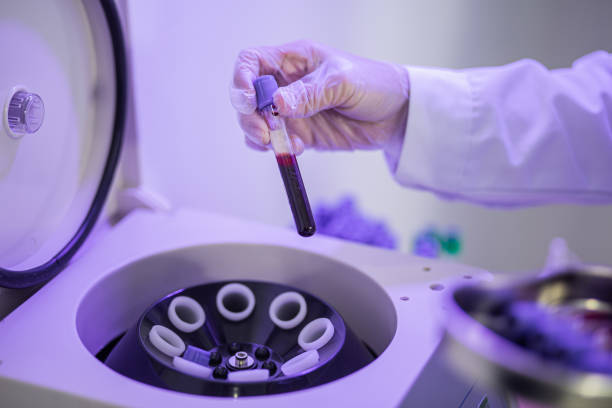The application of PRP in dentistry. It contains a rich array of growth factors and cytokines, which significantly promote tissue repair and regeneration.
Composition and Preparation of PRP
The preparation process of PRP involves collecting venous blood from the patient and using centrifugation to separate the blood into different components, obtaining the platelet-rich plasma layer. PRP contains various growth factors, such as Platelet-Derived Growth Factor (PDGF), Transforming Growth Factor-β (TGF-β), Vascular Endothelial Growth Factor (VEGF), and Epidermal Growth Factor (EGF). These growth factors play critical roles in tissue repair and regeneration.
PRP Extraction and Application Process
Extraction Process
- Blood Collection: Venous blood is drawn from the patient’s arm, usually between 20-60 milliliters.
- Centrifugation: Place the collected blood in a centrifuge for processing. The centrifugation separates the blood into three layers: the red blood cell layer, the platelet-rich plasma layer, and the platelet-poor plasma layer.
- PRP Extraction: Carefully extract the platelet-rich plasma layer using sterile techniques. Often, it is further concentrated by additional centrifugation.
- PRP Activation (Optional): In some cases, activate PRP with calcium chloride or other agents before use to trigger the release of growth factors from the platelets.
Application Process
- Preoperative Preparation: Carry out routine preoperative preparations, including disinfection and anesthesia, before using PRP.
- PRP Injection: Inject the prepared PRP into the treatment area. In dental implant surgery, inject PRP into the alveolar bone or mix it with bone graft materials. In periodontal treatment, inject PRP into the gums or periodontal pockets.
- Postoperative Care: After injecting PRP, follow routine postoperative care measures. Administer antibiotics and pain relief medications as necessary, and advise patients to avoid vigorous activities and irritant foods.

PRP in Dental Implant Surgery
Dental implant surgery is a significant treatment modality in dentistry and oral surgery. The application of PRP in this field focuses on the following aspects:
- Promoting Bone Regeneration: The growth factors in PRP stimulate the proliferation and differentiation of osteoblasts, promoting bone tissue formation. PRP mixed with bone graft materials in dental implant surgery can significantly accelerate bone regeneration and improve implant stability.
- Shortening Healing Time: PRP injections can accelerate the healing process of both soft and hard tissues, reducing postoperative recovery time. Studies have shown that PRP use results in notably shorter healing times, decreased postoperative discomfort, and lower complication rates.
- Enhancing Implant Success Rates: The application of PRP helps form good osseointegration, enhancing initial stability and long-term success rates of implants.
PRP in Periodontal Treatment
Periodontal disease is a leading cause of tooth loss. PRP plays a positive role in periodontal treatment:
- Promoting Periodontal Tissue Regeneration: The growth factors in PRP promote the repair of gums and periodontal ligaments, enhancing the regenerative capacity of periodontal supporting tissues. Using PRP in periodontal surgeries improves surgical outcomes and fosters healthy periodontal tissue recovery.
- Reducing Inflammatory Responses: PRP possesses anti-inflammatory properties, which can alleviate postoperative inflammation, reduce pain and swelling, and improve patient comfort.
PRP in Other Oral Surgery Procedures
Beyond dental implant surgery and periodontal treatment, PRP shows broad application prospects in other oral surgery procedures:
- Post-Extraction Repair: Applying PRP post-extraction promotes the healing of soft and hard tissues at the extraction site, reduces postoperative pain and infection risks, and accelerates recovery.
- Facial Soft Tissue Repair: PRP promotes wound healing, reduces scar formation, and improves repair outcomes in facial soft tissue injuries or surgeries. For example, PRP application can expedite soft tissue healing in cleft lip and palate repair surgery.
- Oral and Maxillofacial Reconstruction: In complex oral and maxillofacial reconstruction surgeries, PRP combined with other repair materials (such as bone graft materials and synthetic bones) enhances tissue repair, increases surgical success rates, and shortens recovery times. In jawbone defect repairs, PRP aids in promoting the integration and healing of bone grafts.
- Treatment of Oral Mucosal Lesions: PRP shows therapeutic potential in treating oral mucosal lesions (such as oral ulcers and lichen planus). The growth factors in PRP promote the repair and regeneration of mucosal epithelial cells, speeding up ulcer healing and relieving patient discomfort.
Advantages and Challenges of PRP Application
Advantages
- Autologous Source, High Safety: PRP is derived from the patient’s blood, avoiding risks of immune rejection and disease transmission, thus ensuring high safety.
- Simple Procedure: The preparation process of PRP is relatively simple, with low requirements for centrifugation equipment and techniques, making it suitable for widespread clinical application.
- Multi-effectiveness: The synergistic action of various growth factors in PRP promotes comprehensive repair and regeneration of soft and hard tissues, making it applicable to various dental diseases.
